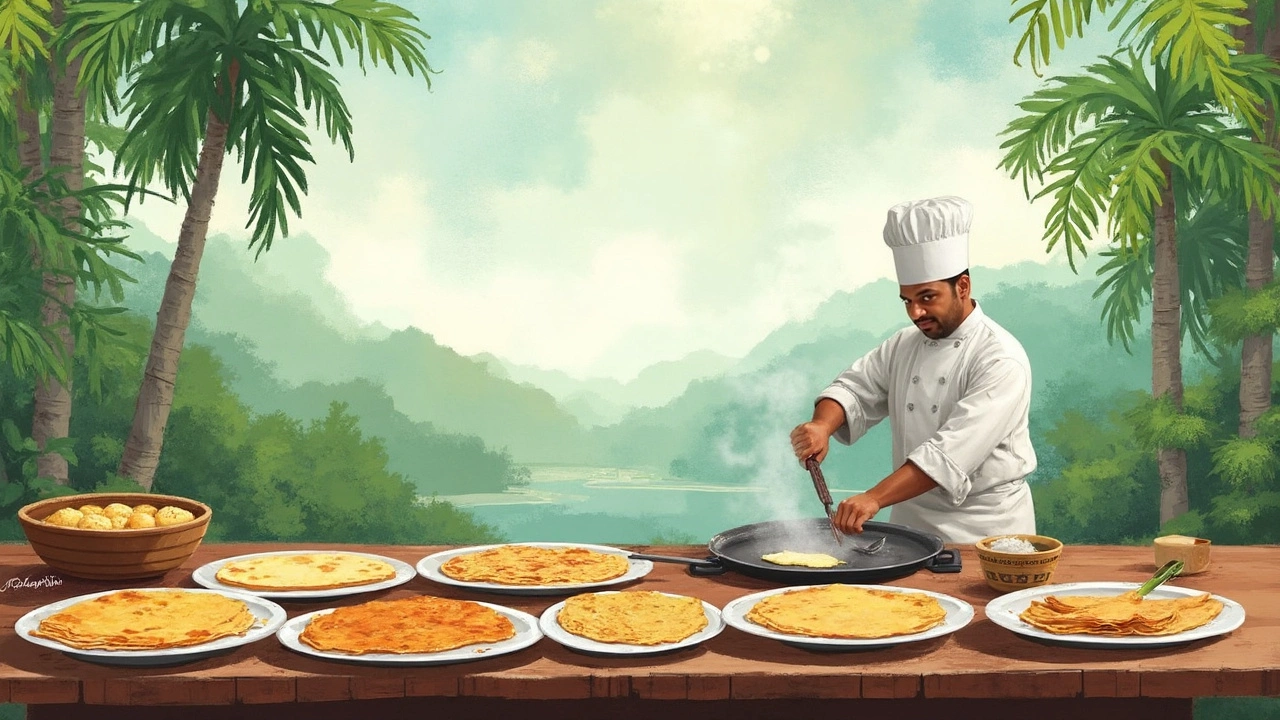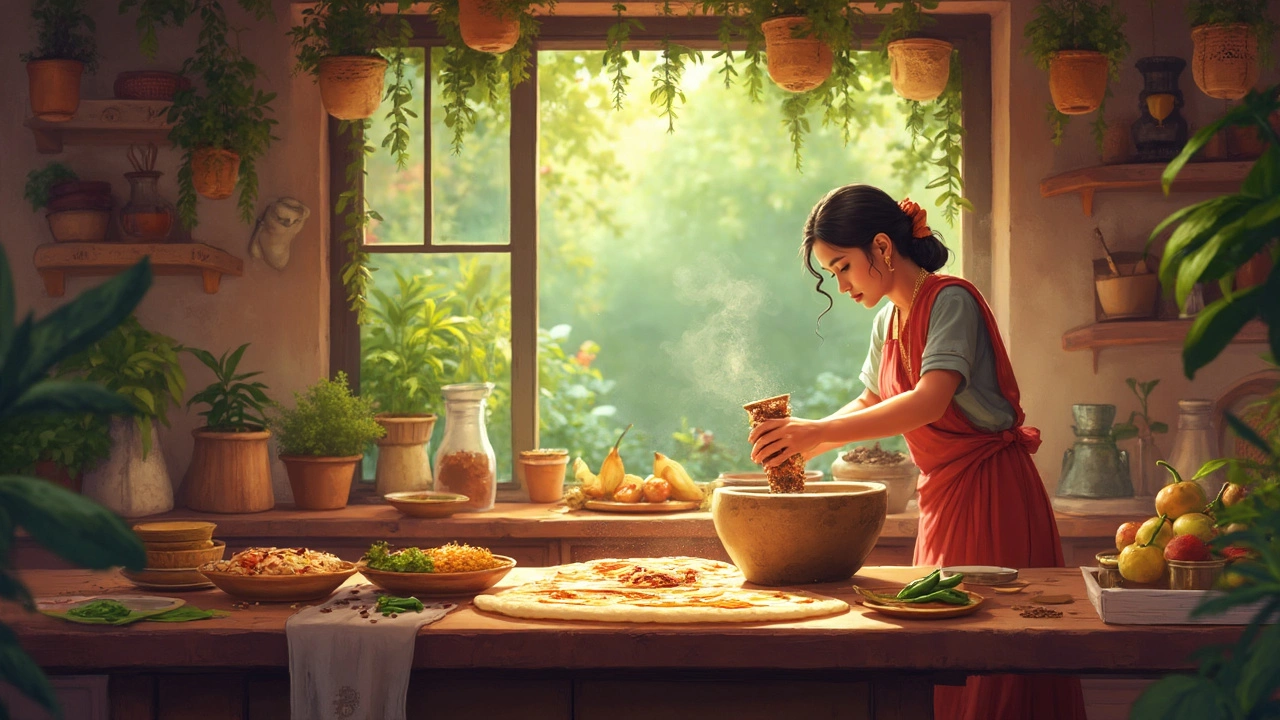If you're a fan of South Indian cuisine, you've likely swooned over a perfectly crispy dosa at some point. The magic lies in the batter, which is a simple yet artful mixture of ingredients. So, what's dosa batter made of? We're breaking it down, ingredient by ingredient.
The basic components are rice and urad dal (black gram). You'll need about two parts rice to one part urad dal, but here's the twist – there are endless varieties of rice and pulses to choose from, each affecting the dosa's texture differently. Common choices for rice include idli rice or even basmati if you want to experiment. As for the dal, whole or split urad dal does the job, just make sure it’s skinned.
Now, you don't just mix them together and call it a day. The magic happens when you soak them separately for a few hours—say, anywhere from 4 to 6 hours. This softens them up enough for the blending phase, which, trust me, makes a world of difference.
- Introduction to Dosa Batter
- Basic Ingredients
- The Fermentation Process
- Regional Variations
- Tips for Perfect Batter
- Frequently Asked Questions
Introduction to Dosa Batter
So, you've fallen in love with the crispy, golden delight known as dosa. But what makes this South Indian staple so darn irresistible? It all starts with the humble dosa batter. This magical mixture is the foundation for creating those delicious, paper-thin crepes that have captured the hearts (and stomachs) of food lovers worldwide.
At the heart of every dosa batter recipe is a simple combination of rice and urad dal. These two key ingredients come together to create a smooth, creamy batter that's later fermented to develop a tangy depth of flavor. Here's the cool part: the fermentation process not only enhances taste but also makes dosas easy on the stomach due to the breakdown of starches.
History and Origin
Dosas have been a part of Indian cuisine for centuries, tracing back to ancient Tamil Nadu. Over time, the recipe has made its way across various regions, each adding its unique twist. This long-standing tradition of dosa-making showcases the regional diversity and creativity within Indian cooking.
The Ingredients Breakdown
While rice and urad dal are non-negotiables, a pinch of fenugreek seeds is often included to aid fermentation and add a subtle hint of flavor. Water, of course, is the other necessary component, bringing everything together into a smooth blend.
Why Fermentation is Key
The fermentation process is where the real magic happens. By leaving the dosa batter in a warm spot overnight, natural bacteria go to work, transforming it into a lightly sour, deliciously aromatic concoction. Not only does this stage elevate the taste, but it enhances the batter's digestibility, making it a great choice for breakfast or as a light meal any time of the day.
Ready to dive deeper into crafting the perfect dosa? Stick around as we explore each ingredient and method to help you master this culinary classic!
Basic Ingredients
Making dosa batter might seem like a culinary art, but it's rooted in simplicity that anyone can master. The two main ingredients are rice and urad dal (black gram). Let's break them down to see why they're essential for the dosa.
Rice: The Foundation
The type of rice you choose can define your dosa's texture and flavor. While traditional recipes often use idli rice, you can experiment with sona masuri or even parboiled rice. Some folks go hyper-authentic with short-grain rice, which supposedly gives the dosa a unique softness. If you're feeling adventurous, try mixing in a bit of poha (flattened rice) or cooked rice to make the batter even fluffier.
Urad Dal: The Secret Ingredient
Urad dal is another dosa superstar. You typically want the split and skinned variant, which is widely available at Indian grocery stores. Here’s a tip: check the freshness of your urad dal. Fresher dal means a better fermentation, giving your dosa a light and airy lift.
Water and Salt: The Unsung Heroes
Water is crucial for the blending process, and its quantity can affect the batter's consistency. Too much can make it runny, while too little makes it thick and stubborn. Salt not only enhances flavor, but also plays a role in controlling the fermentation rate. Add a pinch when blending to set the stage for a balanced taste.
| Ingredient | Quantity (for 4 servings) |
|---|---|
| Idli Rice | 2 cups |
| Urad Dal | 1 cup |
| Water | As needed |
| Salt | To taste |
Understanding these ingredients lays the groundwork for dosa mastery. With the right balance, you’re one step closer to flipping perfect dosas in your own kitchen. So, go grab those ingredients, and let’s move on to the next part: the fermentation stage!
The Fermentation Process
The heart of a good dosa lies in its fermentation. This step is not just a formality; it's the secret to getting that unique tangy taste and delightful texture of your dosa. Let’s dive into how this alchemical transformation works.
The Basics of Fermentation
Once your rice and urad dal are properly soaked, blended to a smooth paste, and mixed together, the next step is to let nature do its work. Fermentation is all about allowing natural bacteria and yeast to do their thing.
Batter is typically left at room temperature for 8 to 12 hours. Warmer climates or summer seasons might need less time, while cooler places might require a tad more patience. You’re looking for a volume increase—say, about 50% more than what you started with—and that lovely, sour aroma wafting up to your nose.
Temperature and Timing Tips
For the best results, aim for a cozy spot for the batter. Room temperature around 25 to 30 degrees Celsius is perfect. If you find yourself in chilly Bristol, don't worry—a warm oven (switched off but with a light on) can work wonders!
- Summer fermentation: 6-8 hours
- Winter fermentation: 10-12 hours
Adjusting for Thickness
Pay attention to the consistency. After fermentation, it should be airy and a bit thicker than pancake batter. Too thick? A splash of water fixes that. Too thin? Add some reserved batter you’ve set aside just in case.
Did you know? Fermented foods like dosa batter are packed with probiotics—those friendly bacteria that help with digestion and gut health.
The transformation from raw ingredients to ready-to-cook batter is as much an art as it is a science. Experiment, observe, and you'll soon master the dosa batter recipe that works best for you!

Regional Variations
When it comes to dosa batter, there isn't just one way to roll. Depending on where you are in India, you'll find some delightful twists and turns to the basic recipe. Each region brings its own flair, and honestly, that's the beauty of cuisine—it evolves!
Northern Twist
In the northern parts of India, dosa batter might incorporate wheat flour for a different texture. This adapts the classic dosa to suit local tastes and available ingredients. It often results in a softer dosa, reflecting the varying local preferences compared to the South.
Southern Secrets
In the south, especially in Tamil Nadu and Karnataka, the batter might include a spoonful of fenugreek seeds. This not only adds a bit of flavor but also aids in the fermentation process. The climate down south helps in naturally fermenting the batter overnight, making it tangy and perfect.
Coastal Curiosities
Coastal regions, like Kerala, enjoy dosas with a unique touch by adding a bit of coconut milk to the batter. This results in a slightly sweeter dosa, which pairs beautifully with spicy curries and chutneys typical of those areas.
Home Experimenters
For our adventurous home cooks, adding a handful of aval (flattened rice) during soaking can alter the texture remarkably, giving you a softer interior. It's a trick passed on in many home kitchens when you're looking for plush dosas!
Regional Stats
| Region | Special Ingredient |
|---|---|
| North | Wheat Flour |
| South | Fenugreek Seeds |
| Coastal | Coconut Milk |
These regional variations in dosa preparation make each dining experience unique. Next time you whip up some batter, maybe give one of these regional quirks a try. Who knows? You might stumble upon your new favorite dosa style!
Tips for Perfect Batter
Getting dosa batter just right can seem tricky, but with a few handy tips, you'll be on your way to making dosas that could rival your favorite South Indian restaurant.
1. Soaking Ingredients
For a smooth dosa batter recipe, soak your rice and urad dal separately. This allows them to absorb water effectively, leading to a finer grind. Aim for a minimum of 4 hours, but overnight soaking is even better if you have the time.
2. Grinding the Batter
When you're ready to grind, use a wet grinder or a high-power blender. Start with the urad dal. Grind it to a smooth, fluffy consistency using minimal water. When you make dosa batter, always add water gradually to maintain control over the consistency.
3. Consistency Matters
- Thick batter might seem easier to flip, but it won't spread thin.
- Too thin? You risk tearing your dosa apart.
- A perfect batter spreads like magic on the tava, so aim for somewhere in between – think pancake batter!
4. The Fermentation Game
This step is crucial. After grinding, combine the rice and dal batter in a large bowl, allowing space for fermentation. In warmer climates, 6-8 hours is enough to yield tangy results. Colder place? Put it in the oven with the light on for a gentle warmth.
5. Test with a Small Batch
Before making a large batch, make a couple of test dosas. Assess flavor and texture. Adjust by adding a spoonful of water at a time or a pinch more salt if needed.
6. Storage
Dosa preparation is often a big weekend task, and storing batter can save time. Fermented dosa batter refrigerates well for up to a week. Just remember to stir well before use.
Frequently Asked Questions
So you've got questions about dosa batter? You're in the right place. Here are some of the most common questions and their answers.
How long should I ferment the batter?
Fermentation is key to good dosa. Usually, you need to leave the batter in a warm spot for about 8 to 12 hours. Of course, this can vary based on the weather. If it's cold, it might take a little longer. You'll know it's done when the batter has risen and has a slight tangy smell.
Can I use any type of rice for the batter?
Great question! While idli rice is the traditional choice, regular rice or even basmati rice is totally fine. Just keep in mind that the type of rice can affect the batter's texture and the final dosa results.
What if my batter doesn't ferment well?
Don't panic! Try placing the batter in a warmer place, like near a stove that's recently been used. If it still doesn't ferment, consider adding a pinch of baking soda just before making the dosas.
How do I know if the consistency is right?
The batter's consistency should be similar to pancake batter - not too thick, but not too runny. When you pour it, it should spread easily across the pan. If it’s too thick, add a little water at a time until it's just right.
What's the shelf life of dosa batter?
Freshly made batter lasts about 4 to 5 days in the fridge. It might get more sour over time, so best to use it within that window for the tastiest results.
Can I freeze dosa batter?
Absolutely, you can freeze dosa batter. Just make sure to use an airtight container. When you're ready to make dosas, thaw it slowly in the fridge overnight.
